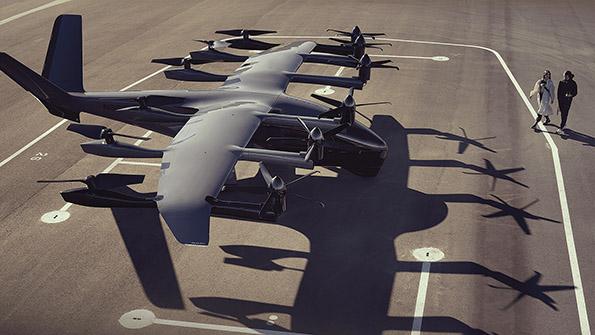
Archer Aviation plans to launch service with its Midnight air taxi in 2025.
The Aviation Week Network’s fleet data team predicts slightly more than 1,000 deliveries of electric vertical-takeoff-and-landing aircraft by 2030, presenting a conservative outlook for advanced air mobility compared to more optimistic forecasts commissioned by the industry.
More than 10,000 electric vertical-takeoff-and-landing (eVTOL) vehicle deliveries are expected by 2040, according to the Aviation Week Network forecast, and almost 30,000 by 2050. Accounting for aircraft retirements, the in-service fleet would comprise approximately 19,000 aircraft by 2050, assuming an initial eVTOL lifespan of five years, extending to 10-plus years by the end of the forecast period in 2050.
Aviation Week’s projections are more conservative than those of forecasts published by industry groups and analysts. Embraer spinoff Eve Air Mobility, for example, forecasts delivery of nearly 100,000 eVTOLs by 2040, while consultancy Roland Berger expects close to 50,000.
- Conservative forecast compares to rosier industry projections
- eVTOL production expected to be in line with other aircraft production segments
Estimated deliveries across three use cases—passenger, cargo and “other” operations, excluding military activity—are included in the Aviation Week Network forecast. The deliveries are divided further into two categories based on size: 1-4 passengers and 5-9 passengers, or volume equivalent where cargo is considered. Drones are not included.
The approach of the Aviation Week Network forecast resembles those underlying traditional aviation models that account for typical factors that can slow aircraft production, such as manufacturing and supply constraints.
For additional context, the Aviation Week forecast for Western-built turbine helicopters anticipates 6,500 deliveries over the next 10 years, whereas the advanced air mobility (AAM) forecast envisions 3,000 eVTOL handovers. The fleet data team does anticipate a boom in demand toward the latter portion of the forecast period, however, with expectations of nearly 17,000 eVTOL deliveries between 2040 and 2050, or nearly three times those predicted for helicopters.
In reaching their conclusions, the Aviation Week Network fleet data team members assumed eVTOL production would not surpass that of other segments of aircraft production, as the new sector will remain susceptible to the same production, manufacturing and supplier constraints as traditional aviation. Furthermore, issues beyond certification and production could affect the market, including pilot availability, delays to commercial autonomy and market consolidation.
The AAM forecast also assumes no significant events will occur during the period that could hinder or prevent the emergence of eVTOLs and that the public largely will accept them into the travel ecosystem. Moreover, the AAM support infrastructure will need to develop at a rate similar to that of eVTOL vehicles so as not to restrict the predicted delivery figures.
Many in the industry expect the eVTOL rollout to begin with air-taxi operations and airport shuttle services to be an early application. Airlines and OEMs already are partnering to provide such services, but the main benefit is that airports and heliports are well-suited to the introduction of AAM operations.
The AAM forecast assumes U.S. commercial operations will begin in 2026, a year after the date expected by many in the industry, with entry into service pushed back to allow for possible delays in type certification. Following the introduction of passenger services, cargo and other operations are expected to emerge shortly thereafter. By 2050, approximately half of the in-service eVTOL fleet is projected to be transporting passengers, with 40% for cargo and 10% for other uses.
The “other” category is limited by a number of factors. Range/loitering capabilities likely will limit eVTOL usage for emergency services, making the new aircraft more suitable for planned operations such as patient transport. Additionally, drones are expected to dominate agricultural applications, which are not considered in this forecast.
The development of the AAM market likely will begin with the 1-4-passenger class, as certification of these aircraft is outpacing approvals of larger eVTOLs. Vehicles in the 5-9-
passenger class are projected to overtake their smaller counterparts as demand grows. This shift is expected to begin in cargo operations, where volume is key.
Ultimately, the fate of AAM remains unpredictable, with many unknowns clouding the outlook. Whether the actual course of events resembles the more cautious outlook in the Aviation Week AAM Forecast—or the rosier projections of industry participants and analysts—remains to be seen.
—With William Moore

